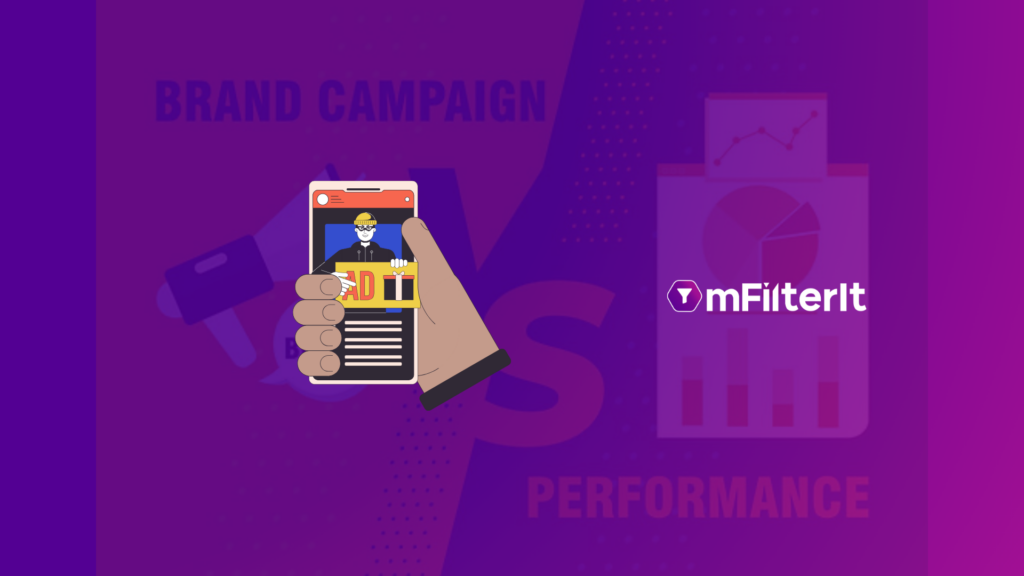Digital Marketing spending is growing at a 9% CAGR globally, and digital media today has become a non-negotiable medium to reach out to consumers/audiences. For a marketer, the 2 obvious choices are to run either performance or brand campaigns to reach, act, convert, and engage with their target audience. While Performance campaigns are directly associated with results achieved, Brand campaigns’ focus is to ensure visibility and recall.
Brand campaigns rely largely on viewability (impressions), while performance campaigns focus on down-the-funnel metrics. Performance marketing focuses on CPI, CPV, cost per sale, conversion rate, etc. on the other hand, the share of voice through mentions, sentiments, tags, etc., measures brand campaigns.
Marketers and advertisers spend a large portion (>50%) of their digital advertising budget on these two campaigns.
Our research suggests that it takes 6 to 8 impressions for someone to build a recall value of your brand. The regular reappearance of the brand ensures higher recognition of the solutions it offers. Viewability, according to IAB is, 50% of the ad’s pixels are visible in the browser window for a continuous 1 second. For larger ads (those greater than 242,000 pixels), 30% of the ad’s pixels are visible in the browser window.
The same applies to video ads but for a minimum of two seconds. Ad viewability is the topmost layer of an ad metric. Fraudsters use fake impressions, bot impressions, ad stacking, and pixel stuffing for impression fraud. Meanwhile, performance campaigns work down the funnel and measure clicks, visits, events, and conversions. Clicks are important because they define the website traffic from online advertising. Visits account for the number of people who viewed the URL associated with the ad.
Similarly, events could include installs, add-to carts, registrations, signups, conversions, etc. A close look at click-to-visit ratios and a visit-to-conversion ratio will give you the efficacy of your performance campaign. Cybercriminals impact these through click fraud, lead generation fraud, CPA fraud, influencer marketing fraud, cookie stuffing, click farms, and domain spoofing. The impact of ad fraud also influences programmatic, affiliate, and retargeting campaigns. The result of ad fraud is higher ad budgets, lower ROIs, diminished brand safety, fraudulent analytics, and infiltration of cybercriminals in customer data systems and ad servers.
Ad Fraud in Brand Campaigns
Impressions are the measure of brand recognition through online ad campaigns. Most digital brand advertisements are based on cost-per-mille (CPM), a.k.a., cost per thousand impressions. Total impressions determine the campaign cost in a CPM advert. The impressions also determine the reach of the advertising channel and total ad viewers in a specific channel.
Ad fraud in impression-based campaigns happens when a fraudster opens a fake website, joins an ad exchange, loads ads on a fake website uses bots for page loading & impressions, and sells the impression inventory to the ad exchange. The common methods of impression fraud include the following:
- Pixel Stuffing: Loading a 1×1 pixel ad on a page counts as an ad served but is not visible to the human eye.
- Ad Stacking: Piling one ad on top of the other and keeping the original ad at the top. The impression counts for all ads, even when the top ad blocks ads below it.
- Fake Websites: Using bad bots to generate impressions on fake websites created solely to sell inventory that does not have human visitations.
- Bot Inventory on Genuine Websites: Fraudsters use bots to fulfill the “most required inventory” needs of the advertisers for acquiring credit and financial gain.
- Auto Impressions: Running in-app ads (even on inactive apps) on mobile devices to auto-generate impressions.
Determining ad fraud in impression-based campaigns is challenging because the analytics reveal more data than performance-oriented ads. You only have the option of comparing CTR with impressions. High impressions mean an advertisement has significant exposure. Typically, campaigns with high impressions experience a high click-through rate (CTR). Under the unlikely circumstance that you have low CTR and high impressions, the ad is possibly incurring fraudulent activity in the background.
Businesses thinking that programmatic or retargeting can resolve issues about brand campaigns should know that it’s not true. Fraudsters have spoofed domains, penetrated customer data systems, and used bots to act as a target for remarketing lists. So, ad fraud is prevalent in brand campaigns. Furthermore, brands should optimize programmatic campaigns by incorporating inclusion lists consisting of URLs where the ads should be placed.
This fear of programmatic ads landing on sites built for ad fraud has become a common affair. Fake websites distort the analytics of brand campaigns. The unexplainable ad impressions can only account for invalid traffic as only 36% of the online traffic is human. Moreover, sometimes programmatic campaigns declare results higher than the population of a location. So, ensuring that ads are delivered to humans is a serious concern.
Ad Fraud in Performance Campaigns
All marketers and advertisers rely on analytics for creating brand strategies. Infiltration of ad fraud into the data falsifies the results, gives false hopes, increases the marketing budget, and doesn’t reach a large proportion of the human audience. Popular researchers quote that ad fraud would exceed $50 billion by 2023. Moreover, nearly 40% of advertisers think that ad fraud is a significant downside of programmatic ads.
For example, fake clicks display that the campaign achieved higher performance than expected, but in reality, engagements with bots will not bring home any business. Ad fraud is still happening even after optimizing the campaign with geolocation, remarketing lists, and pre-bid programmatic placements. Fraudsters use the following methods to target performance campaigns of brands:
- Click Spamming: Executing clicks on behalf of real users without their consent in the background and claiming credit for obtaining financial gain from advertisers.
- Click Injection: Using malware in apps to stay alert about “install broadcasts” and obtaining the last-click attribution through click firing before the new app installation.
- SDK Spoofing: Tricking advertisers to believe that their ad will appear on premium apps, whereas it appears on fraudulent apps through SDK spoofing.
- Lead Generation Fraud: Filling lead forms using real or fake user information with the assistance of bots.
Eliminating Ad Fraud in Marketing Campaigns
Ad fraud in performance campaigns creates the same havoc as in brand campaigns. Advertisers use different trackers for measuring the outputs of the performance campaign. Measuring the campaign’s effectiveness requires analyzing click & acquisition, average CTR, conversion rates, revenue, return on marketing investments, and total customer acquisition.
Advertisers need to identify & eliminate different forms of ad fraud, determine ad revenue using performance metrics, and compare metrics to find points of lead drop-offs for optimizing the campaign performance.
Disregarding or avoiding ad fraud is no longer optional as it directly impacts brand safety. Addressing ad fraud boosts ROAS, reaches the relevant human audience, and stops the ad dollar wastage to fraudsters.
Takeaway
Advertisers no longer doubt the severity of ad fraud in brand and performance campaigns. Moreover, the problem of ad fraud is not resolvable instantaneously by sorting out general invalid traffic (GIVT), as sophisticated invalid traffic (SIVT) would and will persist. Therefore, it is imperative to invest in a solution that prevents and protects you from the nefarious elements on the web.
Get in touch with our experts for deeper insights. Reach out to learn more!



